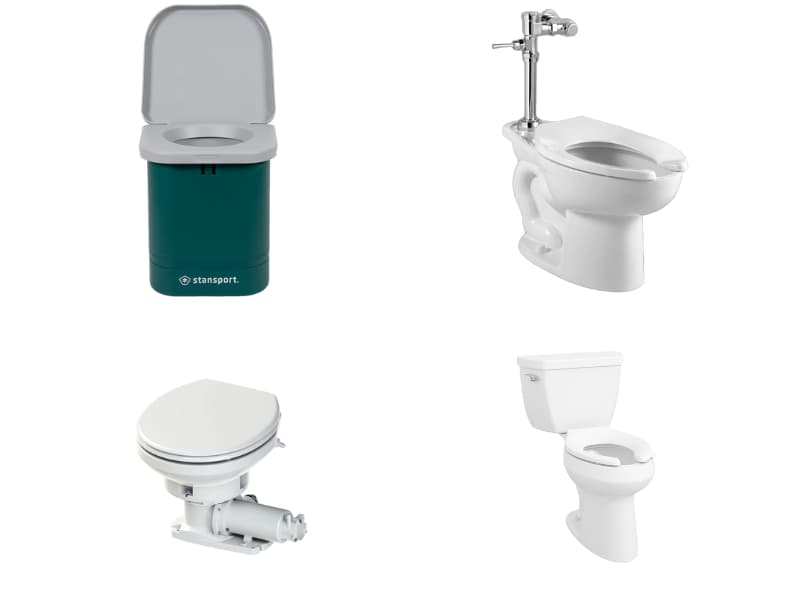How much time and effort should go into something as simple as selecting a toilet? Then, your decision becomes even more crucial, considering that some toilet types could survive for 50 years.
The main types of toilets include dual flush, two-cyclone flush, pressure assistance, gravity flush, composting, up-flush, dry sanitation, and portable toilets. They differ in costs, size, design, and working mechanism, among other differences.
I’ve compiled a list of some of the most critical factors to consider to make the process more straightforward. It includes toilets with numerous models, designs, and flushing systems.

Toilet types
There are many different types of toilets to consider before making your final decision on a unit, depending on the conditions of your home and your preferences.
The following types of toilets are the most popular:
1. Toilets with dual flush
They offer two flush button options, a half flush and a full flush, as the name suggests. We use the half flush for liquid waste, and for solid waste, we use the full flush.
Water efficiency is one of the biggest advantages of a dual-flush toilet. Although they cost more, they are better for the environment and your wallet. Many families, institutions, and nations have adopted this toilet style to combat water shortages.
2. Two-cyclone flushes
The newest choice on the market is the double cyclone flush toilet. They have the same power of a full flush while using less water each time. This contributes to water-saving in the bathroom.
3. Toilets with pressure assistance
The strong flush is the pressure-assist toilet’s major perk. The device forces water into the toilet tank using pressured air. Almost no double flushes are needed with this toilet.
Pressure-assisted toilets are ideal for large families where the toilet is used more frequently. However, they are noisy, which is a drawback to consider.
4. Toilet with gravity-flush
Toilets with a gravity flush are frequently found in home buildings worldwide. When you click the flush button, water from the toilet tank is released into the bowl. The waste is subsequently forced into the trap passage by the water.
Toilets that flush with gravity are quiet, have fewer parts, and require very little upkeep over time. It makes sense why they are so popular on the market. You seldom ever have to deal with a clogged toilet when you have one of these.
5. Composting toilets
Composting, a biological procedure that treats human waste, is how this toilet style acquired its name. After each use, most toilets bulk up with peat moss, coconut coir, sawdust, or wood chips.
When human waste is adequately composted, there is no unpleasant odor, all liquids are evaporated, and the final product is safe and straightforward to manage.
The compost benefits plants, lowering the need for synthetic fertilizers and preserving the nearby water quality. Composting toilets can be an opulent addition to a contemporary bathroom if used and maintained properly.
6. “Dry sanitation” waterless toilets
Water is not used for flushing this toilet. Composting toilets are, by definition, waterless facilities. They are ideal for regions with poor environmental conditions, inadequate water supplies, or insufficient infrastructure.
While not very common in homes, waterless toilets are often utilized at workplaces, outdoor event locations, and campgrounds.
7. Upflush toilets
Upflush toilets do not require complicated plumbing systems or holes drilled into the bathroom floor. Almost completely moveable, they may fit any place on your property. Given how complex toilet placement is, this is a good option to have.
The discharge system is the primary distinction between up-flush toilets and conventional fixtures. A macerator toilet unit and a short pipe make up the mechanism. The macerator processes toilet paper and other solid waste.
8. Portable toilets
These compact toilets are simple to move from one location to another. They are ideal for outdoor activities, including camping, hiking, and festivals. You may contribute to maintaining a clean and safe environment by easily carrying your compact portable toilet.
When cleaning these toilets, always clean the toilet plunger after each use. This keeps germs at bay.
Toilet styles
The style of your toilet should come next. You can select whether you want a single-piece, two-piece, wall-hung, floor-mounted, high-level, or low-level toilet.
1. Two-piece toilets
The most popular toilet design is this one. The water tank and bowl are separate, contrasting with the one-piece toilet. Two-piece toilets can be challenging to clean and sanitize but are inexpensive and highly robust.
2. One-piece toilets
One-piece toilet installations are simple, and you might even do it yourself. Since there are no difficult-to-reach spots, they are simple to clean and maintain.
One-piece toilets are also ideal for bathrooms with limited space because they are smaller. Although they are more expensive, the benefits far outweigh the costs.
3. Back-to-wall toilets
Toilets that flush against the wall are a popular modern design. They take up less room, are attractive, and are easy to maintain. The cistern is concealed within the wall or a piece of furniture, while the toilet bowl is fastened directly to the wall.
Compared to wall-hung toilets, these are less expensive and simpler to install.
4. Wall-hung toilets
These are modern and attractive toilets that hang on the wall. Since the water tank is incorporated into the wall, they conserve room.
These restroom fixtures can be pricey and challenging to install. It would help if you employed a qualified plumber and probably a handyperson to complete the task. This makes them costlier than the alternatives.
The unit is relatively simple to sterilize and undoubtedly has certain benefits.
5. High-level toilet
High-level toilets will enhance the traditional design of your bathroom. They have a cistern high on the wall, which needs to be sturdy or reinforced to prevent any problems.
They also include a lengthy pull chain flush and a long chrome flush pipe for an elegant aesthetic.
6. Low-level toilets
They give your bathroom a traditional appearance, much like the high-level toilet. The flush pipe is shorter because the cistern is installed at a lower elevation. The flush mechanism functions with a lever of a classic style.
You can add a bidet to most toilets to replace toilet paper. Given the typical length of toilet paper roll tubes, it’s a conservation of the environment to use bidets than toilet paper. While toilet paper is recycled paper, it’s still paper and has chemicals. Keep in mind that the type of toilet significantly determines a home’s comfort.
Toilet designs
Some common toilet designs include the following:
1. Single-flush toilets
Toilets with a single flush have a single flushing system for liquid and solid waste. They are the most typical style of toilet flush seen in older homes.
However, they are not environmentally friendly because they use a lot of water, which is one of their most significant drawbacks. Additionally, the flush button frequently breaks quickly, which is an unpleasant duty.
2. Dual flush systems
They provide two flushing options for liquid and solid waste: a half flush and a full flush.
Due to its ability to conserve water, dual flush toilets are becoming more and more common. They are, therefore, cost-effective and environmentally beneficial. They might cost a little bit more than those with a single flush, but they more than make up for it over time.
3. No-touch flushing toilets
Button, lever, or chain flushing mechanisms? You can forget about them all while using touchless flushing systems. They are modern, convenient, and hygienic because they are motion-sensor-actuated.
These flushing systems are frequently found in public restrooms or business buildings.
4. Valve for a flushometer
They employ the flushometer valve system, which is appropriate for tankless toilets. The flushometer valve and the toilet bowl are two essential parts and feature a robust flushing mechanism.
They are typically utilized in commercial, industrial, and institutional restrooms and are not very common in residential buildings.
Outlet trapway types
These include:
1. Exposed outlets
This is the standard S-shaped trapway, and the toilet bowl covers double as bolt covers.
2. Concealed outlets
The S-shape of this particular trapway is hidden. Because of this, the sides are smooth, and the bolt cover caps are made to have a low profile.
3. Fully-concealed outlets
The skirted trapway is yet another name for this one. It is similar to the hidden trapway; however, unlike it, this one doesn’t have bolt caps, and its sides are equally flattened.
Toilet bowl types
There are three different sorts of toilet bowls, and their shapes separate them.
1. Elongated toilet bowl
Of the three, it is the most typical. It is roomy and cozy, with an average dimension of 18 inches.
2. Compact elongated toilet bowl
It combines the elongated form with the circular front bowl. It has the same seat appearance as the round front yet is just as comfy. It primarily provides an additional area for the toilet seat.
3. Round front bowl
Though it takes up the least amount of room of the three, it is less comfy than the elongated variety. Small and smaller comfort rooms are best suited for this one.
Conclusion
Many things must be considered when considering the types of toilets ideal for you and your home. You must consider your location, sanitation system, plumbing, the size of your bathroom, the design of your home, the frequency of toilet use, the effectiveness of the various toilets, and, of course, the cost.
Review each option mentioned above several times to determine which toilets best suit your needs.
